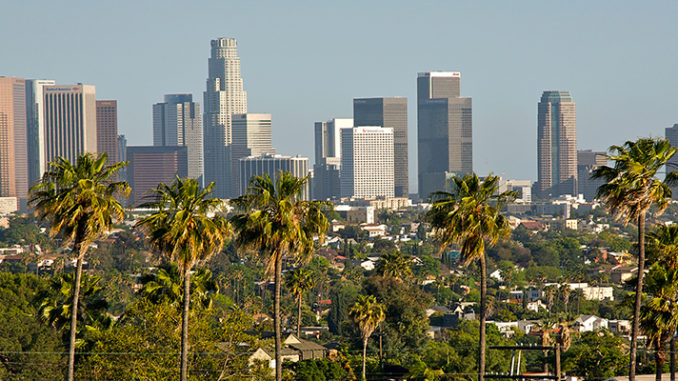
LA Times
California’s 2018 population growth was the slowest in state history, new demographic data show — underscoring shifting immigration patterns, declining birthrates and economic strains that are making it harder for some to afford living here.
The state added 186,807 residents last year, bringing the estimated total population to 39,927,315 as of Jan. 1, according to estimates released by the state Department of Finance on Wednesday. The overall growth rate slipped to 0.47% last year from 0.78% in 2017, the slowest since data collection started in 1900, department spokesman H.D. Palmer said.
Births in the state were down by more than 18,000 compared with the previous year.
Ethan Sharygin, a demographer with the state, said researchers had expected to find a decline in the birthrate but were surprised to see such a large change. One reason for the shift, he said, is the decline in immigrants from Mexico paired with an increase in Asian immigrants.
“The overall profile of immigrants to California is higher education, which correlates to lower fertility,” he said. “With native-born, we see a long-running trend throughout the U.S where fertility has been trending downward.”
Perhaps the biggest force behind the change is higher education rates among women, Sharygin added. That broader trend historically has been masked by high immigration from Latin America, but that is no longer the case.
“More education of women translates into later marriage, later childbirth and then fewer children,” he said.
Dowell Myers, professor of demography and urban planning at USC, said the slow growth also was due to a lack of housing. A report this year by a public policy think tank found that California’s housing supply law hadn’t triggered enough new home building to meet demand.
Myers said the housing crunch makes it harder for younger residents to lay down roots and have children. That is especially concerning as California’s senior population continues to grow at a fast pace. The state faces numerous budget and policy concerns as those older than 65 make up a larger and larger share of the population.
Costs will rise for programs like Medi-Cal, the state-subsidized healthcare system for the poor that provides long-term services and support, including in-home aides and skilled nursing facilities. Local governments and school districts also will have to cope with the rising number of retired workers drawing pensions.
“Old people are holding in place, but we are losing the younger generation. We are losing potential parents,” Myers said. “It is a slow-moving train wreck here.
“Growth in California has stalled out,” he added. “That is pretty amazing.”
Officials noted last May that California’s population had grown by an average of 333,000 people a year since 2010.
Los Angeles County, still the largest in the state, saw population growth fall to 0% last year, state officials said this week. The number of residents dropped from 10,254,658 to 10,253,716 by the end of 2018. This is the first time since 2010 that the population dropped in the county, officials said.
High immigration rates also previously had masked another trend: Californians moving away.
About 5 million people moved here from other states from 2007 to 2016, while about 6 million left California, according to data from the American Community Survey.
In 2015, California saw a net gain of some 177,000 immigrants moving to the state and 105,000 residents leaving, according to data from the Finance Department. Between July 2017 and July 2018, however, out-migration surged to about 160,000 people.
“We want to see who is moving — whether it’s the case that more families are moving out, whether it’s highly educated workers moving in,” Sharygin said.
Part of the birthrate drop is also economically driven, said William Frey, author of “Diversity Explosion: How New Racial Demographics are Remaking America.”
“Because of the recession and post-recession, people are less apt to be having kids,” Frey said.
Sacramento had the largest percentage gain in population among California’s 10 biggest cities, with 1.49% growth — or 7,400 new residents. Bakersfield grew by 1.1%, while Los Angeles grew by only 0.04%.
California added a net 77,000 completed housing units in 2018, compared with 85,297 units added in 2017 and 89,457 in 2016.
Total housing in the state reached 14.235 million units, a 0.6% increase, according to the Department of Finance. Los Angeles added the most housing units in 2018, with 16,525, while San Diego followed with 4,505 and Irvine came in third with 3,384. Santa Clarita and Sacramento rounded out the top five with 2,486 and 2,353 new units, respectively.
Gov. Gavin Newsom has pledged that 3.5 million new homes will be built in California by 2025, but Myers noted the state is not on track to meet that goal.
“It is impossible,” he said.
A report from UCLA’s Luskin School of Public Affairs this year said the state does not have enough land zoned to meet that goal.
A series of deadly wildfires last year also brought drastic demographic changes to some small cities in Northern California, according to the new population estimates.
The Camp fire in Butte County, the most destructive in state history, displaced 83% of the population of Paradise and destroyed almost 90% of the housing stock in the town, a loss of 11,371 units.
Nearby cities of Chico and Oroville each saw their populations increase by about 20% after the fires. Chico added more than 19,000 residents and now has a population of 112,111, while Oroville added 3,682 for a total of 21,773 residents.
California’s fires destroyed 14,600 housing units in Butte County, 900 units in Shasta County, 700 in Ventura County and 300 in Lake County. In L.A. County, Malibu lost close to 500 housing units in the Woolsey fire.
Besides Chico, California’s fastest-growing cities with populations over 30,000 included Dublin in eastern Alameda County, Beaumont in Riverside County and Rocklin in Placer County.



